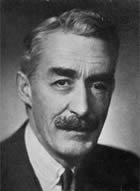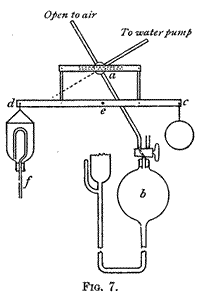In his Nobel address, Ramsay mentions that 'Baly erected an apparatus for the accurate determination of the wavelengths of their spectral lines....... In June, 1903, Mr. Baly published an account of his determination of the wavelengths of the lines in the spectra of neon, krypton, and xenon, photographed by help of a concave Rowland's grating of ten feet radial curvature. In all, the positions of 2,400 lines were accurately measured.' Baly also published (with Norman Collie) some of the earliest UV/Vis spectra of aromatics (J. Chem Soc. 1905, 87, 1332-1346).
But in addition to this spectroscopic work, Travers ' book 'The Experimental Study of Gases' mentions that Baly made some of the earliest measurements of the vapour pressures of liquid oxygen and nitrogen, in parallel with those of Olszewski (which are more famous because they extend over a greater temperature range).
Travers also describes Baly's pump, an ingenious variant of the famous mercury Töppler pump, which could be used to evacuate much large volumes without collection of the gas. The pump was described in Phil. Mag. Sept 1894 and a diagram is shown at right.
"The pump consists of three chambers connected by means of syphons which have a small internal diameter. The tube a is connected with a reservoir, and the tube b through a long vertical glass tube or a valve to the apparatus under exhaustion (sic i.e. evacuation - Ed.). The tap c is connected with a water-pump which is kept running during the whole exhaustion.
'After preliminary exhaustion by means of the water pump, the mercury is caused to rise in the pump till it flows into C; the mercury is then allowed to fall. The vessel C now contains air at the pressure of the water vapour at the temperature of the water in the pump, B contains a Torricellian vacuum, A contains gas at low pressure. When the mercury again rises it drives the gas from the pump-chamber into the chamber B, and in order to prevent any quantity of gas from accumulating in B, the mercury is now and then allowed to rise so far as to fill the chamber. This however, is only necessary during the early stages of the exhaustion. The upper chamber of the pump may be constructed like a Töpler pump in order to collect the gas delivered through it.'
|
|



